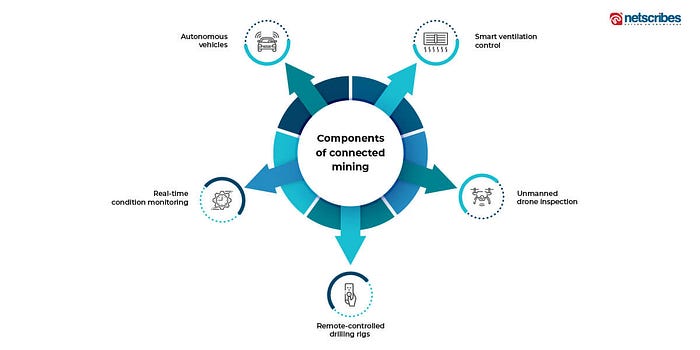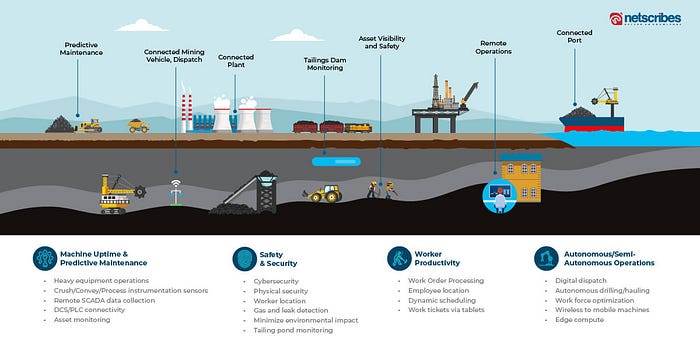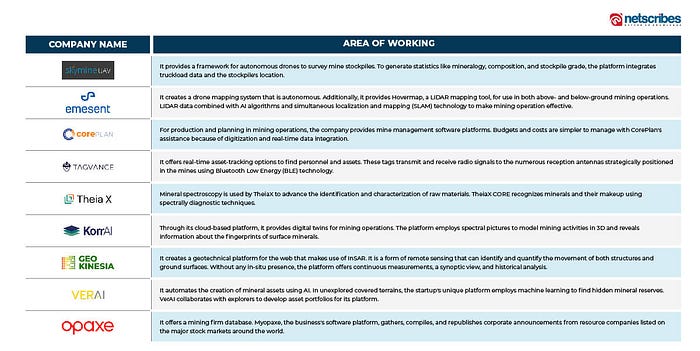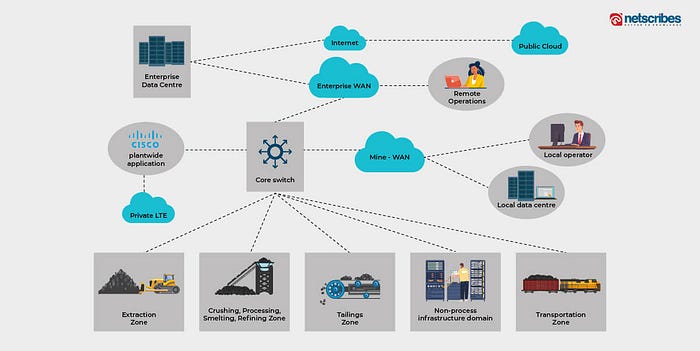The power of connected mining for sustainability
- - Category: Business Opportunities
- - 17 Oct, 2023
- - Views: 12
- Save
More than 45% of the world’s gross domestic product (GDP)

More than 45% of the world’s gross domestic product (GDP) is driven by the mining industry, either directly or through the use of products that help other industries. Also, the mining and quarrying industry makes up about 2.5% of the GDP. The mining industry will significantly contribute to the projected GDP and wealth creation.
Responsible mining practices and efficient resource mineral governance can have a transformative impact in low- and middle-income mining-dependent countries. Incorporating advanced technologies into mining operations has resulted in significant decreases in poverty levels and general gains in social well-being. Connected mining solutions use analytics, tracking, and leveraging cloud technology to manage industrial mining operations effectively.
An interesting update in this space is that the new German raw materials strategy includes a major expansion of the potential for UFK financings for raw material imports and goals for developing and reinforcing local mining activities. The US is one of the top countries considering the mining industry across the globe. This is attributed to the presence of key connected mining solutions vendors including SunCoke Energy, Arch Resources, Alpha Metallurgical Resources, Consol Energy, Cisco, IBM, Caterpillar, Rockwell Automation, and many more.
The connected mine assists mining businesses with data collection and aggregation so they may acquire complete operational awareness and make wise business decisions to enhance mining operations. When it comes to the digital transformation of the mining industry, connected mining refers to a variety of integrated and, in fact, connected mining solutions where people, processes, big data, and equipment of all kinds (stationary and mobile, including vehicles) play a part.
Potential applications of connected mining in all mining operations
- Extraction: It involves integrating and automating mine infrastructure, including ventilation, and mining equipment.
- Process management and optimization: The connected mine controls and automates metal refining operations and optimizes mineral extraction processes.
- Material handling: Smart machines like conveyors, hoists, and stacker reclaimers provide access to collected data for analysis that helps enterprises to make better decisions.
- Mine electrification: A digital electrical system enables the integration of motor management, power distribution, and process control. It captures the information needed for remote monitoring and predictive maintenance.
- Asset performance: Machine learning and scalable systems that monitor the performance of crucial assets and foretell breakdowns, whether they are device-based or enterprise-wide.
- Worker safety: Augmented-reality and real-time mobility tools help to deliver visibility to field workers and help to confirm the right person has the right information at their fingertips.
- Mine-to-market integration: An analytics platform removes information silos, provides visibility of the business, connects disparate systems and applications, and provides informs business decisions.

Connectivity in the mining industry

The mining industry embraces digitalization with 5G-powered technologies such as automation, Augmented Reality (AR) goggles, and IoT devices. To achieve high productivity and cost savings that are essential to digitization efforts, there is an increasing need for hardware, software, and networking solutions to make digital/connected mining a reality.
Underground mining operations create highly stressful and hazardous environments that pose significant challenges for both workers and machinery, as well as communication systems. The presence of wireless access points can exacerbate these challenges, as the physical impacts occurring during operations may jeopardize machinery and essential utilities, including underground internet connectivity.
As mines become bigger and deeper, there are physical data transfer limitations since the equipment that records crucial production data frequently spends a lot of time away from infrastructure-driven internet access. However, a crucial requirement for safe working conditions and production control in mining operations is the capacity to reliably store and swiftly transfer production and operational data in close to real-time from assets. Giving the right people the correct information at the right time promotes better decision-making. The inability to access Wi-Fi and deteriorated cellular networks in deep mines are obstacles to enabling this rapid data transfer to a control center.
Automation systems for the mining industry
Automation has replaced manual labor and made mining processes easier. Automation is becoming more and more popular in the mining industry to decrease the risk to human life and to boost production and efficiency as mines become deeper and more difficult to operate. These days, machine learning (ML) and artificial intelligence (AI) play a significant role in even the largest mining companies with extensive mineral extractions.
Underground mining operations and automated process control systems offer several benefits including improved safety and working conditions, enhanced productivity, mobile fleet management, better vehicle utilization, remote mine control operations, production analysis, performance optimization and enhanced efficiency, and compliance with Environmental, Social, and Governance (ESG) standards.
For instance, to achieve significantly better business operational results, the Cisco industrial automation solution for mining offers guidance to digitize industrial mining environments. It offers network design and implementation ensuring security for mining-related industrial applications that support the processes of extraction, crushing, transportation, processing, smelting, and refining.
Autonomous vehicles used in connected mining
- Driverless trains: The risk to human life is decreased by the complete automation of the system and reduced driver assistance. Greater reliability enables real-time monitoring. Driverless transportation is a clever solution for mines because they are places with poor visibility and dangerous gases that are always a concern.
- Trackless transport: Without the use of rails, laser guidance and GPS technologies can assist workers in navigating the mines and moving cargo.
- Drones: In mines, drones are frequently utilized to navigate across the hazardous and impenetrable parts of the mines where navigation is impossible. As a result, accessibility to isolated locations has improved significantly. Such practices unwelcome human visits and, in the event of a visit that might have been hazardous, it invariably helps saves lives.
- PLC control panels: Control panels accommodate instruments for protection, measurement, detection, monitoring, control, and manage the processes.
Startups and their offerings
Many breakthroughs, ideas, and solutions are emerging from startups and early-stage technology businesses, driving efficiency, decarbonization, and profitability in the energy and mining industries through digital transformation. Some of the emerging tech startups working to optimize operations of the mining industry are listed below:

Digitalization in mining is the future
The use of computerized or digital tools, processes, and data in the mining industry is referred to as “digitalization” and it aims to reduce operational costs, increase productivity, and change mining techniques. When the mining process is digitalized, it transitions from a manual, paper-based operation to a digital platform that integrates automation, siloed systems, ML, AI, and Deep Machine Learning (DML) to improve business outcomes and streamline operations. The number of applications for the mining industry supported by the IoT is growing, ranging from digital twinning to augmented reality (AR) to automation and robots. AI systems that employ machine learning algorithms to record, monitor, and evaluate data produced by sensors located in each piece of mining equipment controls the real and virtual “twin” worlds. Any sensor-monitored piece of equipment can be modified in real-time based on the rules regulating its basic and “learned” parameters.
Telefonaktiebolaget LM Ericsson (Digitalization in mining) — the features of a connected mine, such as automation, mixed reality, and IoT-driven temperature sensors, will require a purpose-built network that guarantees stability and security as digitalization in mining gains traction.
AR and IoT to impact on the connected mining industry
AR enables systems to be used for exploration, training, and physical monitoring purposes. Anyone can virtually “visit” a mine utilizing AR viewing equipment (glasses, goggles, etc.), which allows them to “see” all the mine’s features remotely. These smart AR tools can deliver instructions directly to technicians fixing machinery, enhancing operational standards, and any other system changes necessitated by the data they gather. Work clothes with sensors incorporated can provide information about the working environment and even the workers’ physical health to remote monitoring systems and supervisory staff, enhancing safety outcomes.
IoT, which is characterized by the utilization of a network of sensors and devices connected via the Internet, is the primary technology driving smart mining. By linking devices and eliminating the need for human engagement in data collecting, IoT aims to increase industry efficiency. The IoT-based overarching digital communications network that connects not only various systems within a mine but also those systems to corporate sites worldwide, is the foundation for all digitalization initiatives and strategies. It is made up of a network of wired and wireless communications inside the mine, additionally linked to other places using both “cloud” and digital telecommunications platforms such as 5G. This network enables the distribution of real-time instructions to individuals and systems within the corporate ecosystem. You may not require workers at every location to carry out a task linked to its capability for almost instantaneous command and control.
ABB Ability solutions leverage real-time, data-driven decisions for safer, smarter operations that maximize resource efficiency and contribute to a low-carbon future by combining ABB’s deep domain expertise with connectivity and software innovation.
Connected mining flowchart
By gathering equipment data in real time and publishing it to the cloud and third-party applications, connected mining solutions offer machine visibility, improve maintenance, and provide two-way communication for supervision and control.

Smart mining and mining 4.0
Utilizing networked technologies in the mining industry is known as smart mining. New technologies comprise gadgets like cameras, sensors, and drones that communicate with one another and their surroundings via the Internet. Device networks assist in automating procedures, streamlining operations, gathering useful data, and connecting various mining process components. Smart mining technology helps mines operate more effectively, reduce costs, protect workers, and stop unneeded pollution.
The concept of “Mining 4.0” has emerged because of the explosion in data volume, exponential growth in computing power, and improved connectivity. This and other factors have given the sector access to a wide range of instruments for remote monitoring and system control. The clipboard and pen have been supplanted by mobile devices like phones and tablets. Any manually entered data can be promptly transmitted to the appropriate database, where it can be utilized to either maintain current performance parameters or adjust them to achieve better outcomes, depending on the governing measure.
Startups like Rio Tinto focus on automation, analytics, asset management, climate and energy change, underground mining, orebody knowledge, surface mining, and processing. These mining teams assist the company in making the best technical assessments and decisions to manage key risk hazards, ensure the security of assets, and achieve operational excellence.
How adoption of advanced technologies like AI and additive manufacturing has increased over the years
The digitalization of mining activities generates data streams that mine engineers and managers can use to evaluate operations in real time. AI adds a new dimension to data analytics by identifying trends or patterns, which increases data utility. ML, deep learning (DL), and natural language processing (NLP) are used by startups to provide insights into mining operations. They enable anomaly detection, predictive maintenance, and digital twins for mining operations by enabling pattern and trend identification. Artificial intelligence enables business stakeholders to make quick and informed decisions while automating operations in this manner.
Each mine site has unique assets and equipment for mining, and each machine part uses a lot of raw materials and manufacturing resources. The manufacturing capacity for mining components is capped , which lengthens the lead time for any spare part needs. Modern additive manufacturing techniques enable quick custom production of parts with unforeseen specifications. By utilizing on-site production, 3D printing also reduces the expensive transportation of parts to distant sites in the event of equipment breakdown. Additionally, it improves operational productivity by decreasing downtime for machines.
Accenture connected mine solutions utilize cutting-edge digital technologies, such as data science and machine learning, data engineering, and artificial intelligence architecture, for intelligent asset management by connecting people, equipment, data, and insights across mine, process plant, and transportation infrastructures.
Robotics in mining
The use of robotics in the mining sector is necessary for both opencast and underground mining. Robots can execute a wide range of mining-related jobs, including the placement of explosives, traveling underground after mining to maintain a mine roof, and mining in environments where people cannot work or even exist. Since robotic technology is more precise, dependable, and long-lasting than human labor, productivity has also increased. Drills can compute the ideal quantity of explosives to fill a hole while following predetermined boring patterns.
Underground mining can be done without waiting for the smoke from detonations to clear, and haulage trucks can operate without stopping for breaks or staff changes. The applications of robotic technology used in the mining industry include robotic devices for drilling and bolting mine roofs for improved stability, underground mine navigation or mapping, machinery automation (e.g., automated load-haul-dump trucks), position estimation and evaluation of mine-specific issues, and many more.
Sandvik’s AutoMine system provides a full solution for raising the security and effectiveness of underground mining operations. The open and adaptable AutoMine technology can be adapted to meet the specific needs of each underground mining operation. Caterpillar collaborated with Rio Tinto to develop advanced autonomous water carts. The carts are used for dust suppression.
Connected mining is the next-generation land mine design that integrates surface and underground mining for the management of mining resources and enhanced efficiency in the extraction. Factors such as increasing demand for digitalization in connected mining, mining 4.0 initiatives in industries, increasing adoption of AI, data science and automation, big data, IoT, and increased investment in simulation technology are boosting the adoption of connected mining solutions among tier-1, tier-2 companies across the globe.
Companies should consider investing in connected mining solutions to stay ahead of the competition and reap the benefits of improved efficiency and safety. Connected mining solutions offer numerous advantages such as improved accuracy, increased productivity, and better safety standards. Contact us today to learn more about Netscribes technology solutions and how it can revolutionize your mining operations and improve efficiency.

